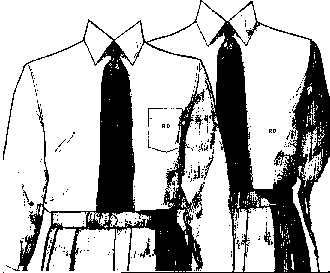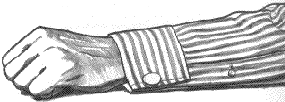THE DRESS SHIRT
|
FITIn fitting a shirt, think first of comfort. The neckband should never choke or chafe, nor should the body of a shirt bind a man's torso. The neckband should fit snugly so that the collar doesn't fall down the neck, with an air space of one-quarter inch in front, allowing the head to turn without chafing the neck. Unfortunately, 80 percent of men wearing dress shirts wear the neckband too tight, either because the shirt has shrunk or because, due to age, the neck has thickened. However, if the neckband is too tight, it will spread the collar, creating a larger space where the tie knot sits. This is not only unsightly, giving a sloppy appearance to the wearer, but is also exceedingly uncomfortable. The body of the shirt should have no more material than is necessary for a man to sit comfortably. Excess material bulging around the midriff could destroy the lines of the jacket. If you do buy a shirt with too large a body, a seamstress can take in the side seams or put darts in the back to reduce the size. The darts are actually a bit more practical, since if you put on weight they can be removed. The length of the shirt is also an important concern. It should hang at least six inches below the waist so that it stays tucked in when you move around. It should not be so long, however, that it creates bulges in front of the trousers. As for the sleeves of the shirt, they should show a full half-inch beyond the sleeves of your jacket. Generally, a good rule to follow is that they should finish approximately one-half inch below the break of the wrist. If you bend your arm and the cuff recedes behind the wrist, the sleeve is too short. A proper size sleeve will allow you to move your arm in any position without withdrawing the cuff. The cuff itself should fit snugly enough to hold its place on the wrist without appearing as a tight bracelet. But it should be small enough that the hand cannot go through it without it being unbuttoned. Or, to put it another way, the cuff should bear some reference to the size of one's wrist.
Cuffs The means by which the cuff itself - either the barrel or French - has been attached to the sleeve is often a reliable indicator of the quality level of the shirt's manufacture. This attachment is no simple task. A big sleeve, one that can fit comfortable around the biceps and forearms, must be reduced in circumference and then sewn to a cuff that fits the smaller wrist. Often the sleeve is simply tapered in its shape so that there is little extra fabric to tuck into the cuff. But if instead the sleeve has been carefully folded into several pleats and then attached to the cuff, the shirt as a whole has undoubtedly been made with care. In England the custom shirtmakers actually sew small pleats in a complete circle around the cuff. French shirtmakers use a symmetrical pattern, folding two or three pleats into the cuff on each side.
Plackets, Yokes, and GauntletsThese three items of obscure terminology can offer further clues to the quality level of a shirt's manufacture. The placket is that piece of material on the front of the shirt where the buttonholes are placed. In the past, it used to be a separate piece of cloth sewn to the front, but today shirtmakers merely fold the edge of the material to simulate this look. All fine dress shirts are made with a placket that is approximately 1 1/2 inches wide. This placket gives the shirt a definite center line and makes a clean finish where the shirt sides join to be buttoned. The yoke is the strip of material sewn across the shoulders to attach the front and back pieces of the shirt. Custom shirtmakers use a split yoke - two yokes jointed in the center - so that they can adjust each shoulder separately for a custom fit. Occasionally you will still see a split yoke, but unless the shirt has been made especially for you, this detail doesn't serve any real function. However, it does indicate a finer-quality shirt. "Gauntlet" is the English term for the sleeve placket, that open area just before the cuff. A well-made shirt has a working button on the placket so that this gap can be closed when the shirt is being worn. The gauntlet button originated in order to enable men to roll back their cuffs while washing as well as to hold the cuff in place. Obviously, a gauntlet button is not one of life's dire necessities, through in certain circles a show of bare forearm is considered in as poor taste as a show of skin between hose and trouser cuff. On the other hand, a buttoning gauntlet does permit a better fit around the forearm and is one more indication of a quality shirt. Mention should also be made here concerning the buttons of a shirt. While most buttons today are of man-made material, a mark of a finer shirt are buttons made of mother-of-pearl. Unfortunately, mother-of-pearl is a more fragile substance than plastic, but its wonderfully deep luster more than compensates for its fragility. A man interested in fine style doesn't mind the effort of having to replace such buttons every once in a while.
MonogramsMonograms are a nice way of personalizing your shirt, though not when they are ostentatiously placed on cuffs or on the collar of a shirt so as to act like a billboard. Keep the lettering simple and the initials discreet (no larger than one-quarter inch high). Place them approximately five or six inches up from the waist, centered on the left half of the shirt. If the shirt has a pocket (and many custom-made shirts do not), center the initials on it. 
Shirt monograms are usually associated with custom-made shirts, but they can be sewn on any store-bought model. The extra cost they incur will show people that you care enough about the way you dress to take the time to individualize your shirt, as well as helping to avoid possible confusion when it is sent to be cleaned.
|
 There
are two types of shirt cuffs from which to choose: the barrel and the
French. The barrel cuff fastens with one or two buttons. The French
cuff is much more expensive to produce, so naturally manufacturers have
taken to marketing mainly the barrel cuff. The French cuff, however,
is far more elegant. When worn under a dark suit, the double fold of
the French cuff combined with the bit of light that is the cufflink
adds a richness to a man's attire that a single cuff and button simply
cannot replace.
There
are two types of shirt cuffs from which to choose: the barrel and the
French. The barrel cuff fastens with one or two buttons. The French
cuff is much more expensive to produce, so naturally manufacturers have
taken to marketing mainly the barrel cuff. The French cuff, however,
is far more elegant. When worn under a dark suit, the double fold of
the French cuff combined with the bit of light that is the cufflink
adds a richness to a man's attire that a single cuff and button simply
cannot replace.